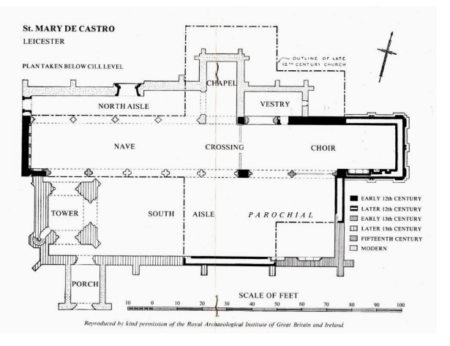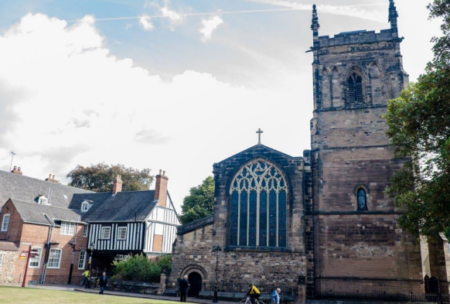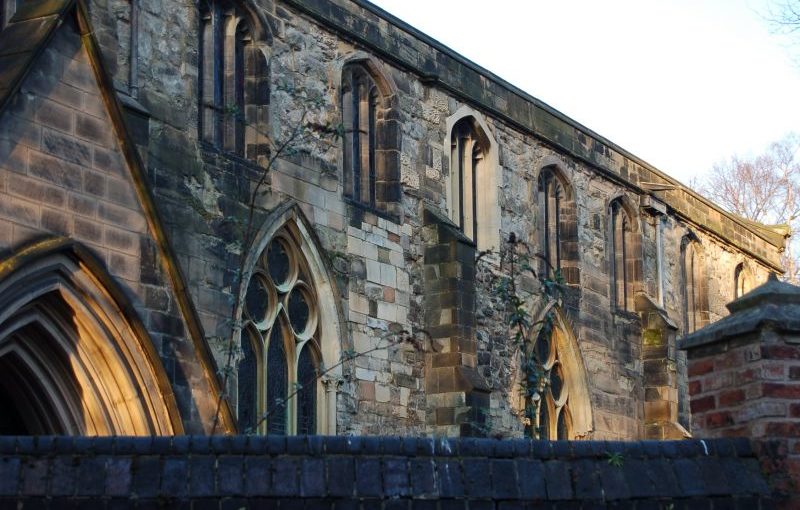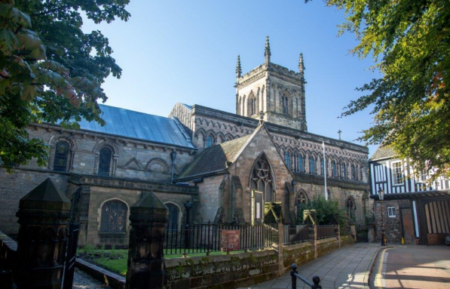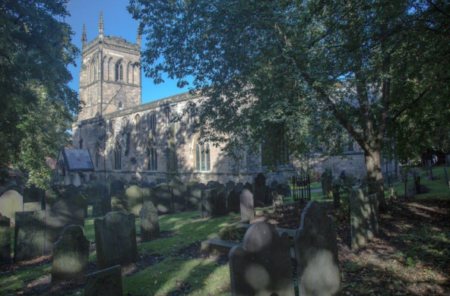ST. Mary de Castro Church
Statement of Significance:
The parish and collegiate church of Saint Mary de Castro stands within the precinct of the Royal Castle of Leicester and was founded by Robert de Beaumont, first earl of Leicester in 1107, and is the second oldest church in the city.
The Church welcomes all who wish to attend services, view the architecture, study the history, or simply spend some quiet time. The church is open on Sundays and weekdays and is included in the Leicester City Heritage and Richard 111 walking trails. Pictorial guide books are available on request from volunteer members of the congregation who man the door.
The Church is located adjacent to De Montfort University and is within the conservation area which includes the Castle Park Gardens, and within a short walking distance from the Cathedral of St. Martin and the Richard 111 Museum.
Edward the Elder and his sister Ethel-fleda (children of Alfred the Great) are credited with the foundation of the first church on the present site of Saint Mary de Castro in 918.
On arrival in Leicester the Normans pulled down the church building and Hugh de Grantensil built the castle in 1090, he also built the church of Saint Mary on the Saxon church foundation. Robert de Beaumont, earl of Leicester, in 1107 rebuilt and increased the length of the Nave by adding the sanctuary which became the chancel. A vestry and sacristy were added to the north side and also two transept chapels.
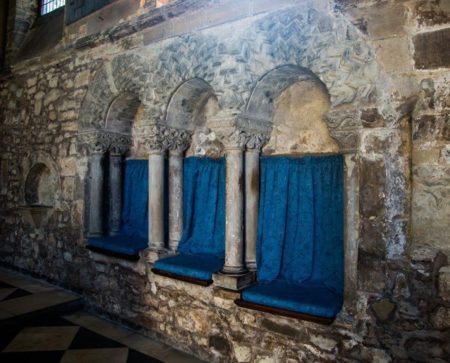
After the sacking of the town in 1173 the castle and the church were rebuilt and the chancel was lengthened to its present dimensions including the repositioning of the Norman sedilia in the south wall which is an outstanding example of Norman architecture, and is of the old fashioned type each
seat being higher than the one next to it.
Early in the 13th century the nave was heightened by the introduction of the clerestory above the Norman windows and a freestanding tower was built.
It is interesting to note that in 1201 the first meeting of discontented Barons took place in Leicester castle and there is no doubt that the Barons attended the church of Saint Mary de Castro, therefore, associating this church with the discontents which led to the Magna Carta.
In 1240 the narrow south aisle and transept were demolished and the present large south aisle was built and enclosed the tower within the church building. Within the sanctuary south wall are early English style sedilia, and the east window is the largest in Leicestershire. The south aisle was dedicated to the Holy Trinity with its own high altar, this created a parish church for the people alongside the collegiate church with screens between them.
In 1258 the first Mayor of Leicester was chosen in Saint Marys Collegiate Church. From 1265 the Earldom of Leicester gave to Prince Edmund, second son of Henry the Third, the Royal Castle and Chapel which remained so until 1485.
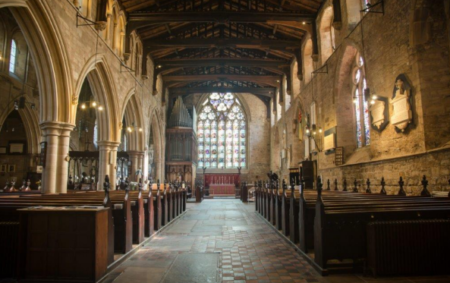
The Collegiate Church and Parish Church were divided by screens between the piers, therefore, we have two churches under one roof where services were held simultaneously at both high altars until 1400, at that time the bishop appointed one of the canons to be vicar of the parish church. Later the
dean of the collegiate church (appointed by the abbot of Saint Mary in the Meadow) was made the vicar. Saint Mary’s in the Meadow was dissolved in the Reformation period. The wall between the chancels was removed and the chancels united.
From 1377 to 1399 John of Gaunt was Earl of Leicester and personal friend of John Wycliffe, bible translator. Wycliffe was under the protection of John of Gaunt from the Church authorities and was given the living as vicar of Lutterworth. No doubt he often preached in Saint Mary de Castro. John of
Gaunt was also Geoffrey Chaucer’s patron and it is believed that Chaucer married his second wife, Phillipa de Roet, in the church.
The Dukes of Lancaster made Leicester a favourite residence, and when they became the Royal house the castle was maintained and occupied by the Royal family from time to time. During such events the Collegiate Church of Saint Mary and the castle would undoubtedly be used by the court. On one of the three occasions when Parliament met in the castle, in 1426, Henry the VI was knighted in St. Mary’s Church, though at the time he was only a boy. On another occasion Parliament sat and
was known as The Parliament of Bats, i.e. clubs, since arms had been forbidden for obvious reasons.
Richard the Third is known to have visited “my castle in Leicester “in 1484 and on previous occasions and would, of course, have attended mass in the church. He would have entered through the north door. For such an important visitor there was doubtless a throne in place near the rood screen.
At the end of the 14th century a spire was erected on the tower and has been repaired and rebuilt several times, until 2014 when it was found to be structurally unsound and dismantled.
The present entrance is through the north wall Norman door, a handsome example of Norman architecture, and was rebuilt in the north wall when the north aisle was built in the 15th century.
The meeting in which the Town Council of Leicester resolved to hold the town against the forces of Prince Rupert in 1645 was held in St. Mary’s. Both Crown and Parliament forces stabled their horses in the church during the Civil War. Until 1836 the living of St. Mary’s was in the gift of the Crown.
In 1852, Sir Gilbert Scott (architect) designed three Victorian arches to replace the unstable large brick arch built in 1800 the large brick single arch allowed for a better view of the preacher in the pulpit.
The South Aisle roof was extensively repaired in the 1930’s and is the widest single span timber roof of its kind in the country.
The Church and Tower are floodlit in the evening.
The Churchyard
St. Mary’s church yard provides, for the living, a pleasant, quiet and green oasis in the heart of a busy modern city. The church yard is now closed for burials and is in the care of the Leicester City Council, however, there is an area set aside for the interment of cremated remains in a garden of remembrance.
There are some very good examples of the slate carving on headstones done by the Swithland School of the 18th and 19th century. They range in colour from purple green to dark blue.
John Lewin, who is generally said to have introduced the hosiery trade into Leicester, is buried in the churchyard. In front of the north window of St. Anne’s Chapel lie the remains of Miss Susannah Watts who wrote the first popular guide to the town, “A Walk Through Leicester”, in 1804.
The Churchyard also possesses a gruesome relic, viz. the grave of two young men, William and John Corren, on April 1st 1822, were both executed on the same day because of a drunken brawl in the town where in a man lost his life.
The South boundary of the churchyard is the early medieval wall for defence of the castle from the south east. Holes were pierced in the wall for cannons at the Siege of 1645 when Prince Rupert made a successful attack on Leicester. Through the openings may be seen the neighbouring Newark Houses
Museum Gardens.
Within the churchyard are two large chestnut trees with some lime trees within the area. Wild flowers blossom according to the season, viz. snow drops, bluebells, daffodils, and cow parsley, common male ferns, cranes bill, wall rue and heart’s tongue fern cling to the wall crevices.
The Furnishings
Seating – There was no general seating until 1489. The current pews designed by James Mitchell and Sir Gilbert Scott were installed between 1847 and 1855. Bench ends are intricately carved and some have “Green Man” type faces.
Organ – The first reference made to an organ is in 1550 when Roger Oakley was paid 13 shillings and 4 pence for playing the instrument. The organ was next mentioned in the church records in 1777. In 1860 Foster and Andrews of Hull were commissioned to build a three manual organ. It was substantially rebuilt and enlarged by Joshua Poritt of Leicester between 1878 and 1880. In 1960 restoration and further electrification took place along with major tonal modifications. It is situated at the east end of the Trinity aisle with some 2000 pipes ranging from a few inches to 16 feet.
Screen – The rood screen between the nave and chancel is Victorian top and bottom, with the pillars being Jacobean from the early 17th century. The pulpit and eagle lectern stand at either end of the screen.
The north aisle contains St. Anne’s Chapel and was given by the Misses Noble in memory of their father. The north aisle was constructed in 1543, but collapsed in 1667. The current aisle and chapel were designed by Sir Gilbert Scott in the 19th century where the Blessed Sacrament is reserved in an aumbry.
The sacristy door located on the north wall of the chancel is dated by the saw-tooth decoration as 12th century, though the woodwork dates from the 15th or early 16th centuries.
The reredos behind the high altar was designed by the Victorian architect George Fredrick Bodley. It is oak and alabaster depicting the crucifixion with St. Mary and St John at the foot of the cross. The lower panels depict the Annunciation of the Lord to the Virgin Mary by the angel Gabriel. The altar is now freestanding.
The Trinity Altar – The old parish altar is now represented by the Trinity altar in the south aisle and was presented in 1957. Sedilia and piscina were built in the early English style. They are fine examples of their time. The altar floor is paved with flagstones, some with coats of arms or other designs.
In the later 1200’s when the narrow south aisle was doubled in width a door was built in the late gothic style across from the north door.
The parish church had its own rood screen with a staircase leading to the rood loft but is no longer in existence, but the door is still in place as is also part of the original spiral staircase.
On the south aisle wall are four pieces of carving, two are probably 16th century Flemish and two, slightly later from Germany. Beside them are copy brasses of Chaucer’s parents.
All Soul’s Altar on the south wall of the Trinity aisle is dedicated for remembering people who have died. A votive candle stand is nearby should anyone care to light a candle in memory of a departed one. A book of remembrance is nearby in a wooden and glass display case.
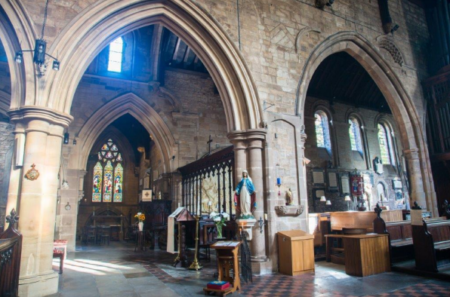
A statue of The Blessed Virgin Mary is located against a pillar between the two chancels. Given in the 1920’s it was “ordered out” by the bishop as being “Popish” some members of the congregation discovered where it had been put. They “stole “Our Lady back and so she stands today along with a unique votive candle stand given in memory of a recent church warden and made by George Pickard of Leicestershire. Another statue of the Virgin Mary stands in a niche over the north door and one in St. Anne’s Chapel, together with, a statue of St. Therese of Lisieux next to the pulpit.
Font- Under the tower stands the font, dating from about 1200 and rests on a high circular base, the iron protruding from the wooden top is one of the original devices ordered by Pope Gregory X, ordered it fixed to all fonts with a chain to prevent theft of holy water. An older Norman font was discovered in 1821 supporting a staircase in the castle.
To the north of the font are some sixty inlaid 14th century floor tiles.
Plans to relocate the baptismal font to the front of the Trinity aisle will offer an improved liturgical and symbolic meaning to Christian initiation than leaving it in its dark cramped site under the tower.
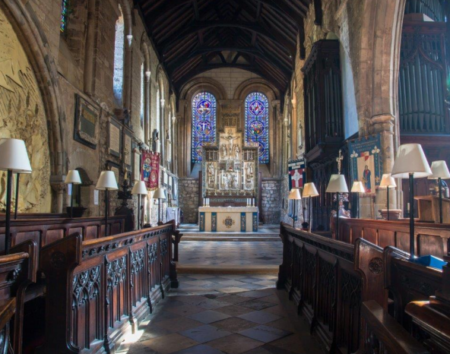
Windows – All of the stained glass windows are Victorian. On entering St. Mary’s one is struck by the subdued light, the two tall windows on either side of the reredos in the east end of the collegiate chancel are noted for their brilliant blue colour made by William Wailes of Newcastle in 1866.
The large east window of the south aisle is a memorial to Rev. John Brown, which was completely restored in 2005. The large west window of the nave shows Old Testament prophets and St. John the Baptist, was also recently restored.
The window in St. Anne’s Chapel is Pre-Raphaelite in style.
Some windows were removed in 1935 and in the 1980’s to allow in more light.
Silver plate and addenda – much of the early church plate has been lost but there are two chalices and patens of 1688 and two flagons of 1722. The pewter collection plates are dated from 1779 to 1805. The churchwarden’s staves, processional crosses, and sanctuary lamps are memorial gifts.
St. George- In the Trinity aisle beside the organ stands a statue of St. George the Martyr Patron Saint of England. A service and procession is held annually on April 23rd in his honour.
The Tower contains ten bells within a steel frame which replaced an earlier wooden structure. The largest bell was cast in 1630 and the latest two bells were cast in 2010 by Taylor’s bell foundry of Loughborough. The bells may be rung by a carillon as well as pulled by ropes. A door behind the font
leads to a spiral staircase up to the bell ringing chamber in the tower.
Monuments- St. Mary’s contains some excellent funerary monuments including that of Hugh Watts (d. 1656). Probably the most famous one is that of the Rev. Thomas Robinson (d. 1813) in the neo-classical style, standing in his robes and pointing to heaven. In 1785 he had built the earliest
parochial schools in Leicester. A memorial to William Billers (d. 1658) is on the north wall of the tower. He was a haberdasher by trade and three times Mayor of Leicester. In 1606 shops were open on Sundays, Billers was one of twenty three leading tradesmen who signed a petition asking for
shops to be closed on the Sabbath day.
National and International Significance
St. Mary de Castro, for many years has attracted both United Kingdom and foreign visitors. The number of visitors have increased with the discovery of Richard the Third. The week of the interment ceremonies attracted over 900 visitors to the church. Since then with the open door policy, many local and overseas visitors have come singly, in small and large groups and on Heritage Trail and Richard the Third guided tours.
In October 2015 the King Richard the Third Society of the U.S.A. will attend a Latin requiem mass in his honour, at their request in St. Mary’s.
The Europa Cantat, a group of European choirs and musicians, held their main midlands concert in St. Mary’s in 1977. On arrival the choir from Iceland were amazed by the two great chestnut trees in the churchyard as they come from a treeless country.
Regional and Local Significance
The church hosts two annual festivals on St. George’s Day and on the anniversary of the beheading of King Charles the Martyr. Civic services arranged for the Lord Mayor or courts are conducted when requested as is the annual Freemasons’ service.
St. Mary’s participates in the Leicester Early English Music Festival and in the Castle Park Festival both held annually. There is a choral sung mass held on May bank holiday with city and county choristers in the Trinity aisle under St. Mary’s director of music.
De Montfort University makes use of the church on occasions, it is hoped to continue and expand this relationship.
Due to the recent Richard the Third activities and publicity about the church many people who have visited and live locally have found their first visit architecturally and historically interesting and educational as well as being a quiet prayerful place. The churchyard continues to be a place to wander and explore. A flag of St. George flies outside the north door entrance.
Plans for increasing space at the west end of the church where people can meet before and after services, a servery under the tower and toilet provisions would be very welcome including the repositioning of the font near to the statue of St. Mary in the south aisle. These alterations will not take away from the beauty of the building.
The people of St. Mary’s must respect the past, live for the present and invest in the future.
Following a visit on the 28th January 2000, by His Royal Highness, Charles, The Prince of Wales, a letter from St. James Palace reads: “It is such a special place which is so clearly loved by those who worship in it. It deserves to be conserved and preserved for future generations to enjoy and treasure”
